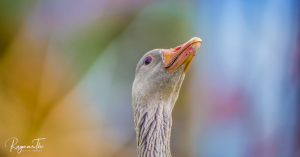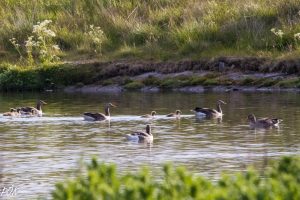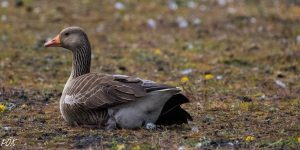The graylag goose (Anser anser) belongs to the waterfowl family (Anatidae) along with ducks and swans but is a member of the gray goose genus (Anser) as well as 11 other species. The graylag goose is the largest species within the genus and is the largest goose in Iceland. An adult bird weighs 6-8 lbs and is 28-36 in long. The male birds are a bit larger than the females but the sexes look alike. As the name indicates, the graylag goose has a very gray look. The head, back, and wings are gray and the belly is white with black spots. The bill is pale pink or orange with a lighter nail at the tip. The feet are light pink with webbed toes for swimming. The birds’ wings are large and strong with a wingspan of 59-71 in. A pale gray forewing and white rump is noticeable during flight. Young birds look similar to adults but have lighter colors and a dark nail on the bill.
Graylag geese stay all around Iceland
The graylag goose is mostly a migratory bird in Iceland and arrives in great numbers early in spring. The first birds arrive in the southern part of the country at the beginning of March. They start feeding and building energy reserves for the upcoming nesting season. The male, who is often called “Gassi” in Icelandic, keeps guard and protects his female. He gives her time to feed and accumulate energy reserves for incubation. When the female is incubating, the male turns quite aggressive towards intruders. He hisses, bites, and flaps his wings when unwanted visitors come too close.
The Icelandic graylag goose population has grown in the last decades because food supply has become more stable. Grain production has increased, in Iceland during the summer and in Britain during the winter. The minimum population size is 35-40 thousand breeding pairs or about 100 thousand birds in fall. The graylag goose lives all around Iceland and nests both on the mainland and on islands. A considerable number of geese nest along the banks of Iceland’s largest rivers and they seldom nest further than 300m above sea level.

Did you know?
- Geese must eat sand and drink water in order to digest their food. That is the reason why they sleep close to both.
- When new flight feathers grow during the molting period, the geese are frail and bloody. Their wings often bleed during the molting stage and Icelanders say that the bird is “being hurt”.
- An Icelandic word for gooselings is “gögl”.
- Geese travel mostly during twilight hours and fly in a V-shape. The birds take turns being the flight leader since the bird in the front reduces the drag for the birds flying behind. This saves the flock energy in long flights.
- The graylag goose is the ancestor of most domesticated goose species today. The oldest documents that mention domesticated geese are over 3000 years old!
The gooselings often follow strangers, watch out!
The graylag goose nests early, the first ones in late April though most of the birds lay eggs in May. The clutch contains 3-6 white eggs that weigh about 165 g each, about the same size as normal chicken eggs. The geese insulate their nest with goose down and dry hay and often hide it in a dense cover close to water or the shoreline. The female incubates while the male keeps guard. As other waterfowls, the goose is very devoted to its incubation and only leaves the nest to drink or to preen. The female loses a lot of energy during the 27-28 incubation days. It is important for her survival that she has enough energy reserves when egglaying begins. Gooselings leave the nest about 24 hours after hatching. They follow their parents to feeding grounds and the family stays together until they leave the country late in the fall. Gooselings’ diet is mostly the same as that of the adults, consisting of herbs and berries. At first, the gooselings are yellow and greenish but they soon begin to get the gray color of adult geese.
Gooselings often seem very tame, though they are wild. They tend to be attracted to people, vehicles or other bird species, and even follow them around. This behavior has gotten many gooselings into trouble. Furthermore, people can easily get into trouble with gooselings’ parents. If they feel that a person is getting to close to their young, they can often turn aggressive.

“Goose-slaughtering sites” – an old tradition
The graylag geese molt their wing feathers in mid-summer, as other waterfowls do. It is, therefore, unable to fly until in the middle of August. During this molting period, the geese form large flocks on rivers, lakes, and at sea to stay far from predators. Back in the days, people herded molting geese in large groups and slaughtered them. There are still remains of these goose-slaughtering sites around Iceland. Goose slaughtering is long forbidden today and geese are protected by law during the nesting and molting seasons. The hunting period for graylag geese, which is one of the most popular hunting species of Icelanders, is between August 20th and March 15th. About 30-45 thousand graylag geese are hunted in Iceland each year.

Graylag geese fly to the UK in the fall… or do they?
Late in the fall, the graylag geese form large flocks of hundreds of birds and leave the country together. Icelandic geese migrate to Great Britain and most of them stay in Scotland during the winter. By tracking marked birds, however, scientists have found that a part of the population stays in Norway and the Netherlands. Some graylag geese do not migrate from Iceland but stay here during the long winter. About one thousand geese stay in the Reykjavík area and highly depend on the locals to feed them. An even larger number of them stay in potato fields and barley fields in southern Iceland during the cold winter months.
Graylag geese mate for life, in a monogamous relationship. If a mate dies, which often happens, the other one quickly finds someone else to pair with. The lifespan of wild graylag geese is about eight years but they can reach a much higher age, even over 20 years. Graylag geese are social birds who are rarely seen alone. There is a strong hierarchy within a group of geese and they fight for the dominant status. Usually, the most experienced bird is ranked the highest in the group. The graylag geese “talk” a lot, loud honking and babbling is very characteristic for the species. They can often sound like an amateur trumpet player, but they have many other complex calls worth listening for.
Interesting goose-links
- Key information about geese, from The Royal Society for the Protection of Birds
- A few facts from the Wildlife Trust
Author: Dr. Þórður Örn Kristjánsson
Photographer: Ragnar Th. Sigurðsson & Dr. Þórður Örn Kristjánsson

